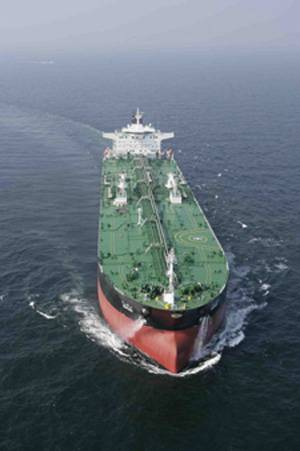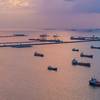Tanker Market Outlook 2008 – 2012
McQuilling Services has released its January 2008 Tanker Market Outlook for the period 2008 through 2012. The report, produced each year in January, presents a forecast for 10 trades in the five major tanker sectors through 2012. Six dirty trades and four clean trades are evaluated and discussed.
Since a year ago the world economic outlook has changed significantly in the short term. Growth is expected to slow from 5.2% in 2007 to 4.8% in 2008. The slowdown was sparked by the US economy and its travails in the sub-prime mortgage market which have spread to the international financial markets. There is significant downside risk in the growth forecast.
Global oil demand growth is forecast to increase 1.6% in 2008, 2.0% in 2009 and 2.2% in 2010. These figures result is 600 thousand barrels per day less demand in 2010 than anticipated last year. Notwithstanding this reduction tanker trade matrix considerations will boost transport demand for crude and dirty products in 2008 by between 1.2% to 4.1% percent depending on the vessel sector. McQuilling expects a 3.3% demand growth for VLCCs in 2008 versus 0% growth observed in 2007.
Biofuels use, increases in North American refining capacity and high oil prices in the short term, and global refining system rationalization in the longer term points to demand growth for seaborne transport of clean petroleum products reducing over time. McQuilling estimates 4.4% growth in clean products seaborne transport demand in 2008, up from 2.4% in 2007 but down from the 6.6% compound annual growth rate since 1998.
The pace of ordering new tankers has slowed from mid-2006 but not before establishing substantial orderbooks across tanker sectors. Double digit tonnage supply increases are expected in 2009, the year with the greatest deliveries scheduled. For the balance of the forecast period a developing tonnage supply surplus will keep pressure on freight rates.
A considerable program to convert tankers into floating storage units, dry bulk carriers, heavy lift vessels and single hull tankers into double hulls tankers developed over the course of 2007. This program unexpectedly removed a substantial amount of tonnage from the trading fleet and mitigated some of the impact of the large newbuilding program. As a result, spot markets averaged higher in 2007 due partly to constrained tonnage supply and we expect rates in 2008 to improve further as many more vessels exit the fleet for conversion projects. Because of this conversions program many of the older single hull vessels scheduled to phase out in 2010 have been or will shortly be removed from the fleet. Therefore, the “2010 effect” on the market has been drastically diminished from earlier estimates.
The full industry impact of the Hebei Spirit oil spill in early December 2007 off the South Korean coast is still not clear. There is still the possibility of an accelerated industry phase out of single hull tankers as a result of this incident. Even without imposed regulation, it is almost certain that the trend will be more and more away from the use of single hull tankers during 2008 and beyond.
Despite weaker freight rates in 2007 compared to 2006, new and used asset prices increased by 9.3% on average across the five tanker sectors and are showing no signs of weakening. Internal rates of return for tanker projects show a dramatic reduction since a year ago. Nonetheless, many vessel owners are still contracting new tonnage. The mechanisms for restraint are emerging, however. International financial markets are undergoing turmoil driven by the troubles in the US economy. This has led to tightening credit supply which will help to throttle the more speculative acquisition transactions in the market looking for money.
Crude oil prices are forecast to be in the $85 per barrel range in 2008. Bunkers prices are highly correlated to crude price and we expect bunkers to average $400 per metric ton in 2008, increasing pressure on time charter equivalent revenues over last year In this environment, McQuilling expects vessel operators will monitor vessel speeds closely and reduce whenever possible in order to reduce fuel consumption and costs. McQuilling also believes there will be increased focus on backhaul scheduling and triangulated vessel deployments by operators to improve vessel utilization and TCE return.
Conclusion
The January 2008 McQuilling Services Tanker Market Outlook anticipates a tanker marketplace rebounding somewhat in 2008 on demand outpacing supply in most sectors. This is not to say that demand is expected to be large – rather that the number of exits from the fleet due primarily to scheduled conversion projects will be larger. Beyond 2008 this Outlook paints a weakening portrait of the tanker industry caused in a large part by an increasing tonnage surplus. McQuilling’s sense is that while events may conspire to influence the market higher or lower, the strength anticipated in the post-2010 period is gone. To reverse the trend will now require an unforeseen event or events which - witness the recent oil spill in South Korean waters - is certainly not out of the question.
About the Report
McQuilling Services’ Tanker Market Outlook is produced each year in January, and presents a forecast for 10 trades in the five major tanker sectors through 2012. Six dirty trades and four clean trades are evaluated and discussed. Spot freight rates in the tanker marketplace are influenced by many things. McQuilling uses a systematic methodology combining analytical techniques with practical experience and observations to project freight rates through 2012. McQuilling’s comprehensive approach begins with a review of the global economic context and continues through the development of annual and monthly freight rates in ten major tanker trades. In the Outlook it discusses expectations of where the spot market in the various sectors may be headed over the next few years. Using our approach to evaluating the tanker market we have consistently forecast market levels across sectors close to actual results observed achieving a 3% forecast error over ten trades in 2007.
For more information, Email











